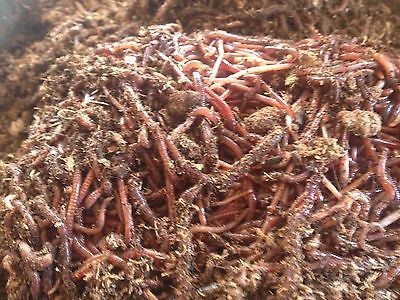Red worms: Great for gardens
Red worms: Great for gardens
Blog Article
Why Red Wigglers Are the most effective Selection for Your Composting Requirements
Red wigglers have actually arised as a premium choice for composting due to their exceptional capability to effectively decay natural issue while creating high-quality worm spreadings. The trip to effective vermicomposting involves more than simply getting these worms, and recognizing the suitable problems and misunderstandings bordering them is crucial for maximizing their capacity.
Benefits of Red Wigglers

Red wigglers prosper in a range of problems, making them versatile to different composting setups, from little containers to larger systems. They master vermicomposting, where their task develops a high-grade end product referred to as worm spreadings, abundant in valuable microbes and nutrients necessary for plant development. This all-natural fertilizer promotes dirt wellness, boosts moisture retention, and improves plant durability against bugs and diseases.
Moreover, utilizing red wigglers can dramatically reduce methane emissions related to garbage dump waste, adding to environmental sustainability. Their convenience of care and minimal maintenance requirements make them suitable for both newbie and knowledgeable composters. Ultimately, incorporating red wigglers right into your composting technique not just fosters effective waste administration yet also elevates the top quality of your compost.
Ideal Composting Conditions
Producing optimal composting conditions is essential for taking full advantage of the efficiency of red wigglers in damaging down organic matter. These worms thrive in a controlled environment that imitates their all-natural environment, which mostly contains damp, dark, and well-aerated areas. To achieve this, maintaining a temperature series of 55 ° F to 77 ° F is crucial, as extreme temperatures can hinder their task or even bring about death.
(purchase red worms)Wetness degrees must additionally be thoroughly kept track of; red wigglers need a moist setting, ideally around 70% dampness content. Excessive dampness can cause anaerobic conditions, while inadequate wetness can cause dehydration. In addition, a balanced carbon-to-nitrogen proportion, preferably around 25:1 to 30:1, supports ideal digestion and nutrient cycling.
Additionally, the composting medium should be maintained loose and oxygenated, enabling correct air movement. This not just benefits the worms yet also help in the break down of natural materials. By making certain these ideal problems, composters can produce a thriving ecological community that boosts the performance of red wigglers, ultimately bring about abundant, nutrient-dense garden compost.
How to Start Vermicomposting
Beginning vermicomposting is an uncomplicated procedure that can yield substantial advantages for both your garden and the atmosphere. To begin, select an ideal container, such as a plastic container or a wood box, guaranteeing it has ventilation openings for air movement. A dimension of about 15 to 20 gallons is ideal for small operations.
Following, prepare the bed linens product, learn this here now which must be a mixture of shredded paper, cardboard, and coconut coir. This bed linens offers a comfortable habitat for the worms while keeping moisture. Go for a bedding depth of around 4 to 6 inches.
As soon as the bed linen prepares, present red wigglers into the container. A populace of about 1,000 worms suffices for processing kitchen area scraps successfully. After including the worms, incorporate a balanced mix of eco-friendly products, such as vegetables and fruit scraps, in addition to brown products, like dried out fallen leaves.

Nutrient-Rich Spreadings
(red wiggler worms)The red wigglers in your vermicomposting system play an essential duty in generating nutrient-rich spreadings, an extremely in-demand organic fertilizer. These castings, usually described as worm humus, are the outcome of the worms absorbing raw material and secreting it in a form that is exceptionally beneficial for plants.
Rich in crucial nutrients such as nitrogen, phosphorus, and potassium, worm spreadings give a balanced resource of fertility that enhances soil framework and advertises healthy plant development. Furthermore, they contain advantageous bacteria that better enhance soil wellness, helping in nutrient absorption and condition resistance.
The slow-release nature of worm spreadings makes sure that nutrients are available to plants over an extensive duration, decreasing the threat of nutrient leaching and thus contributing to sustainable horticulture practices. Unlike synthetic fertilizers, which can lead to soil destruction over time, worm spreadings improve the soil's physical, chemical, and organic buildings.
As a result, integrating red wigglers right into your composting efforts not only minimizes waste however also produces a premium organic modification that significantly benefits yards, landscapes, and potted plants alike. - red wigglers
Common Mistaken Beliefs Regarding Worms
While numerous individuals identify the benefits of utilizing worms in composting, numerous mistaken beliefs continue about their biology and habits. One typical misconception is that all worms are similarly effective for composting, when in fact, just particular species, like red wigglers, flourish in organic waste environments. These worms are particularly adjusted to composting, making them suitable for this objective.
One more misconception is that worms are vulnerable and need overly details conditions to survive. In truth, red wigglers are quite durable, able to tolerate a series of temperatures and moisture degrees, supplied they are maintained within an ideal array.
Furthermore, some believe that worms eat all sorts of food waste indiscriminately. However, red wigglers choose specific organic products, such as fruit and veggie scraps, and can battle with meat, dairy products, and oily foods, which can produce odors and draw in bugs.
Verdict
To conclude, red wigglers represent an ideal choice for composting as a result of their rapid decomposition abilities and versatility to different settings. The nutrient-rich castings created dramatically boost soil wellness, advertising lasting gardening methods. Understanding the perfect conditions for vermicomposting and attending to usual misunderstandings regarding these worms better strengthens their role in reliable waste administration. red wigglers. By leveraging the benefits of red wigglers, people and areas can add to a more lasting and eco friendly strategy to organic garbage disposal.
Report this page